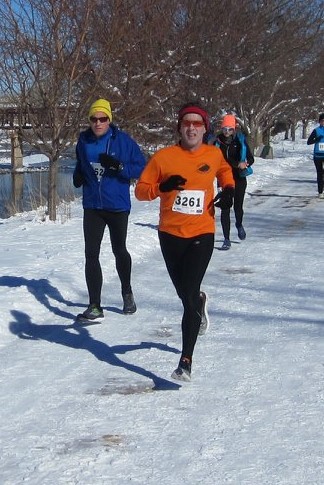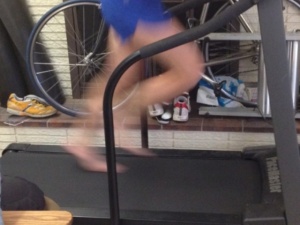
How to run fast and efficiently on ice, and how it can improve your efficiency on any surface.
If you live in a place with a real winter, you’re probably going to have to deal with snow and ice when you run. Running on ice does not have to be that treacherous, and can actually improve your running form. In this article, I’ll talk about technique and strategies for running on ice.
This is not about traction devices. FWIW, the only traction device I use is cheap and simple to make screw shoes on hilly & icy trails. I almost never use anything on roads or flat trails.
Hit the ground running
“Pawback” is a key part of an efficient stride. Your foot should be pulling back when it hits the ground, like a cat pawing. And, you should land with your feet under your body mass. This is true whether running on dry or slick ground. If you land with your foot still going forward or even flat, with your foot in front of your body, or on your heels, you are braking and losing momentum. Like driving a car in the snow, your best control is when you are continuing forward.
Shorten your stride. Besides being more efficient, a short, quick (and light) stride gives you more control, and better ability to adjust quickly. With quicker strides, you are landing with less force, thus less likely to slide out of control. And, with lighter, quicker strides, you are better able to quickly adjust your stride and body weight if/when you slip.
We have a natural tendency to lean back and on our heels when we’re afraid. If you do any skiing, you know that’s what most beginners do, and that’s exactly what makes skiing and control harder. The same is true with running. You want to lean forward slightly, stay on the balls or middle of your feet, stride back, and keep moving forward.
This won’t prevent slipping on ice. It may even feel a bit like falling – good running form almost feels like falling forward. Your feet may slip back on ice, like running on loose dirt, but if you keep your momentum moving forward and your feet moving under you, you should stay in balance and hardly notice it.
Powdered or Glazed?
Some surfaces are inherently more dangerous than others.
Snow usually has better traction than ice. Aim for the white stuff, a dusting of snow atop of ice, over glazed ice. Dark patches may indicate ice or dry pavement. That can be hard to distinguish at night or from a distance. At night, I assume it’s ice and am more cautious (unless I know it’s mostly clear). The edges of snow, where it changes to pavement, are often slick. This is where it melts and refreezes as ice. Try to avoid these edges by adjusting your stride. It’s better to take extra short strides, than to lengthen your stride or leap (landing with more force).
If patches of dry pavement are small and scattered, it may be better to just stay on the snow and ice. You risk hitting more edges. And, different surfaces have different feels, and it takes a few strides for your body to adapt. Two or three strides on pavement may take more effort adjusting than it’s worth.
Turning on ice is hard, just like with driving. Slow down and shorten your stride before a curve. Then, go through the curve with very short & quick strides, staying nimble up on the balls of your feet.
Painted road surfaces can be slicker than unpainted pavement. Try to step over or around them, without making abrupt lateral changes.
Changing surfaces can be tricky – pavement to dirt, sidewalk to street, path to bridges. Not only might the snow/ice differ on the new surface, but the feel is different. Subtle cues from your feet, allow your body to automatically make adjustments and stay in balance. When the feel changes, it takes a little time for your body to adapt. If you know it’s icy, or don’t know what it’s like, slow yourself by shortening your stride (not by braking on your heels) before the change, and transition with caution.
Rapid changes in direction or speed can be risky. Look ahead to anticipate changes, and adjust your stride and line before you get there. When you see that you are going to need to change lines, drift over gradually, making small lateral changes, and try to hit any new surface going straight.
Snow can make it easier or harder. Running in a few inches of new snow is a lot of fun. When the snow is soft, you fly right through it. Packed snow gives pretty good traction too, as long as it’s not crusty. Snow can actually make it easier on trails, by filling the gaps between rocks.
Old, crusty snow is different than ice, but can be as hard to run on. You don’t know what’s underneath – soft snow, ice, hard ridges – often until it’s too late. When the snow is more than a few inches deep, the crust can cut your ankles, and hard ridges of snow can twist them. If you can’t avoid deep crust or exposed areas of hard, uneven snow, go very slow, and walk if needed. If there’s lots of it, find somewhere else to run.
When running icy/snowy hills, control is best when your feet are under your body mass. Shortening your stride even more, keeps your feet under you more. Going uphill, try to hit the hill straight, and carry momentum into the hill. Think of lifting your knee up to initiate the next stride and leaning into the hill (from the ankle, not bending at the waist), using gravity to help propel you forward, rather than pushing down against the slick ground. Slow yourself before a downhill. Then, hit the descent as straight as possible. Stay up on the balls of your feet and don’t lean back. You lose control and can’t adjust your balance from your heels, or when your feet are in front of you. It’s better to tip-toe down on your toes, than to slide down on your heels. If it’s really bad, you can turn your feet and side step up or down.
Practice
Running on ice takes practice to learn the technique, and experience to gain confidence. It takes practice to learn how to fall forward, and how to be comfortable doing it. That’s good running form – using gravity and momentum to your advantage – dry or slick. Start by practicing on dry ground. Lean forward – keep your body straight, leaning from your ankles, not bending over at your waist – stride quickly and kick your heels back until it starts to feel like you’re falling. Find your comfort limit, and then lean a little beyond it. See how fast you can go by striding faster, not longer. Over time, you’ll become more and more comfortable with this. When you take it to the snow and ice, you’ll want to tone it down a bit – slightly less forward lean, and slower running speed; though still leaning forward and with a fast stride rate.
I actually look forward to racing in tricky conditions. While my times may be slower, I know that I handle them better than most other runners, and can use it to my competitive advantage. The 2005 Greenland Trail 50km had just about every trail condition possible – dry, snow, ice, slush, mud – at different parts of the course, and different times during the day. I remember passing lots of runners, gingerly taking 7 or 8 steps to get through a snow drift or ice patch, while I cruised through with just 1 or 2 steps. There was a race at Cherry Creek, in February, with ice and slush on the road. I took straight lines through slush and ice, maintaining my speed, while others slowed and/or maneuvered wide around slick spots. I don’t have to be that aggressive when I’m just out for a training run, but I don’t fear the ice either.
You don’t have to be afraid of the ice and snow. While you need to be more cautious, it doesn’t have to keep you from running or racing. Practice. Build confidence. Get out there and have fun.
3/19 – An article by Alex Hutchinson, Sweat Science guru and author of Endure – https://www.outsideonline.com/2392683/treadmill-vs-outside-running
Be smart. Train Smart.


